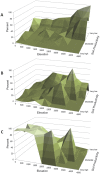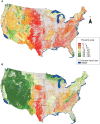Representation of ecological systems within the protected areas network of the Continental United States
- PMID: 23372754
- PMCID: PMC3553064
- DOI: 10.1371/journal.pone.0054689
Representation of ecological systems within the protected areas network of the Continental United States
Abstract
If conservation of biodiversity is the goal, then the protected areas network of the continental US may be one of our best conservation tools for safeguarding ecological systems (i.e., vegetation communities). We evaluated representation of ecological systems in the current protected areas network and found insufficient representation at three vegetation community levels within lower elevations and moderate to high productivity soils. We used national-level data for ecological systems and a protected areas database to explore alternative ways we might be able to increase representation of ecological systems within the continental US. By following one or more of these alternatives it may be possible to increase the representation of ecological systems in the protected areas network both quantitatively (from 10% up to 39%) and geographically and come closer to meeting the suggested Convention on Biological Diversity target of 17% for terrestrial areas. We used the Landscape Conservation Cooperative framework for regional analysis and found that increased conservation on some private and public lands may be important to the conservation of ecological systems in Western US, while increased public-private partnerships may be important in the conservation of ecological systems in Eastern US. We have not assessed the pros and cons of following the national or regional alternatives, but rather present them as possibilities that may be considered and evaluated as decisions are made to increase the representation of ecological systems in the protected areas network across their range of ecological, geographical, and geophysical occurrence in the continental US into the future.
Conflict of interest statement
Figures








References
-
- Miller KR (1982) Parks and protected areas: considerations for the future. Ambio 11: 315–317.
-
- Pressey RL (1994) Ad hoc reservations: forward and backward steps in developing representative reserve systems? Conserv Biol 8: 662–668.
-
- Margules CR, Pressey RL (2000) Systematic conservation planning. Nature 405: 243–253. - PubMed
-
- Fairfax SK, Gwin L, King MA, Raymond L, Watt LA (2005) Buying nature: The limits of land acquisition as a conservation strategy, 1780–2004. Cambridge: The MIT Press. 357 p.
-
- Pressey RL, Humphries CJ, Margules CR, Vane-Wright RI, Williams PH (1993) Beyond opportunism: key principles for systematic reserve selection. Trends Ecol Evol 8: 124–128. - PubMed
Publication types
MeSH terms
LinkOut - more resources
Full Text Sources
Other Literature Sources
Miscellaneous

